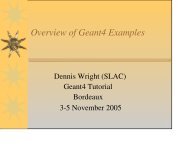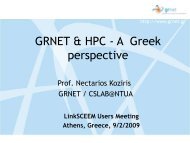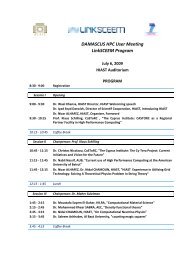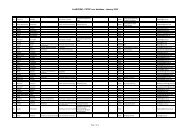Introduction to Stereoscopy for Archaeology - LinkSCEEM
Introduction to Stereoscopy for Archaeology - LinkSCEEM
Introduction to Stereoscopy for Archaeology - LinkSCEEM
You also want an ePaper? Increase the reach of your titles
YUMPU automatically turns print PDFs into web optimized ePapers that Google loves.
<strong>Introduction</strong> <strong>to</strong> <strong>Stereoscopy</strong><br />
<strong>for</strong> <strong>Archaeology</strong><br />
Roper<strong>to</strong>s Georgiou<br />
STARC
Outline<br />
• What is “stereoscopy”?<br />
• His<strong>to</strong>ry of S3D<br />
• Human Vision<br />
• Analogue/Digital Tools<br />
(Software & Hardware)<br />
• S3D <strong>for</strong> <strong>Archaeology</strong><br />
(Ancient Theatre of Paphos, Virtual Direc<strong>to</strong>r)
What is Stereoscopic 3D (S3D)?<br />
• Stereopsis - stereo meaning "solid", and ”opsis” meaning view or sight<br />
• <strong>Stereoscopy</strong>, or stereoscopic imagery; the technique <strong>for</strong> recording threedimensional<br />
visual in<strong>for</strong>mation by using the characteristics of human<br />
binocular vision <strong>to</strong> re-create the illusion of depth of an image as of the<br />
real world<br />
• The technique relies on presenting two slightly different images on <strong>to</strong> the<br />
retinas of our eyes, which the brain au<strong>to</strong>matically fuses in<strong>to</strong> a single view or<br />
a spatial representation using the visual cortex located at the back of our<br />
brain. Visual cortex can be characterized as the visual encoding/decoding<br />
engine of the human’s physiology.<br />
• The majority of living beings on earth are using vision <strong>to</strong> accomplish various<br />
tasks <strong>for</strong> tracking various objects in 3D space.
STARC
Origins of Stereoscopic 3D<br />
• The stereoscopic systems are dated back <strong>to</strong> 280 A.D when Euclid was the first <strong>to</strong><br />
recognize the concept of depth perception by humans.<br />
• In 1584 Leonard Da Vinci studied the perception of depth accurately produced in his<br />
paintings and sketches.<br />
• In 1611 Giovanni Battista della Porta wrote detailed descriptions of the projection<br />
theory of human stereo vision based on Euclid’s notions; in Johannes Kepler's<br />
“Dioptrice” (1611).<br />
• In 1826 was the discovery of “monoscopic traditional pho<strong>to</strong>graph” by Joseph<br />
Nicephore Niepce using camera obscura.<br />
• Early stereo pho<strong>to</strong>graphy was indroduced in 1838 when Sir Charles Wheats<strong>to</strong>ne<br />
invented the stereoscope.<br />
• The discovery of anaglyph 3-D appeared in the 1850s by Joseph D'Almeida which<br />
present stereoscopic imagery using color separation red/green filters .<br />
• In 1891 Ducos du Hauron registered a patent <strong>for</strong> printed anaglyphs, the<br />
“Stereoscopic print” with subtractive filtering using red/blue filtered glasses.<br />
• At the end of the 19th century motion pictures are patented and the u<strong>to</strong>pian dream <strong>for</strong><br />
many inven<strong>to</strong>rs <strong>to</strong> create stereoscopic motion pictures in three dimensions becomes<br />
reality (Edward Muybridge, Luis Le Prince, Lumiere Brothers)<br />
• In 1895 John Ander<strong>to</strong>n registers a patent <strong>for</strong> a polarized stereoscopic projection<br />
system. This system uses polarization projection filters and a pair of analyzers<br />
(glasses) having polarizes therein in order <strong>to</strong> admit the corresponding image <strong>for</strong> the<br />
left/right imagery projected by two lanterns.
Natural Camera Obscura<br />
www.paleo-camera.com
“View from the window at Les Gras”- Nicephore Niepce<br />
(1826) , earliest surviving monoscopic pho<strong>to</strong>graph of a scene taken<br />
with a camera obscura.
Epochs of S3D<br />
• 1838 – 1952<br />
Discovery and experimentation<br />
• 1952 – 1980<br />
The “golden era”<br />
The first popular S3D movies - S3D exponentially decreased in popularity because the technicians<br />
had excluded several stereoscopic ”laws” <strong>for</strong> making a movie due <strong>to</strong> limited technological <strong>to</strong>ols.<br />
Alignment and Synchronization problems in between the two images was causing eyestrain and<br />
headaches <strong>to</strong> the viewers. Stereo was used as an impression <strong>to</strong>ol.<br />
• 1980 – Beginning of new millennium<br />
The “revival”<br />
The early digital age and the appearance of IMAX 3D projection <strong>for</strong>mat<br />
attempts <strong>to</strong> bring people back in<strong>to</strong> the theatres with several technological<br />
advancements in the S3D framework.<br />
• Beginning of new millennium<br />
The “renaissance”<br />
Full Digitization and huge advancement in software and hardware.<br />
Advanced Computer Graphics, new S3D <strong>for</strong>mats in cinema<strong>to</strong>graphy<br />
(RealD, Dolby 3D, XpanD), 3D TV’s and moni<strong>to</strong>rs, 3D cameras<br />
and support from major media production companies and TV channels<br />
(Discovery channel).<br />
•
<strong>Introduction</strong> <strong>to</strong> Human Vision
Human Vision and Epipolar Geometry<br />
• Two Eyes = Simulation of Real Three Dimensions (3D)!<br />
• Epipolar geometry refers <strong>to</strong> the geometry of stereo vision<br />
(triangulation). When two cameras view a 3D scene from two<br />
distinct positions, there are a number of geometric relations<br />
between the 3D points and their projections on<strong>to</strong> the 2D<br />
images.<br />
• Human interocular(CG interaxial) distance is about 2.4 inches<br />
distance in between the centers of the two retinas. By<br />
replicating human vision and by using virtual or real cameras<br />
having 2.4 inches interaxial distance(normal scale) as the<br />
threshold of human stereo vision; we can compute<br />
“Hypo-Stereo” or “gigantism” if interaxial < normal scale or<br />
“HyperStereo” or “dwarfism” if interaxial > normal scale so <strong>to</strong><br />
create size effects on objects and make them feel giant or<br />
small. This is used extensively as a stereo effect technique in<br />
cinema<strong>to</strong>graphy.<br />
• In most cases in Stereo 3D(S3D) archaeology is not <strong>to</strong> translate<br />
“gigantism” and “dwarfism” but <strong>to</strong> replicate human vision on the<br />
screen(natural geometry, perspective) . Replicating human<br />
vision is identified as “ortho-stereoscopy” and it is used in<br />
scientific visualization(1:1 ratio original scene:representation).<br />
2.4 inches<br />
Average interocular<br />
distance of Human vision<br />
STARC
Monoscopic vs. Stereoscopic vision<br />
• Depth perception<br />
Realizing the layout of our surrounding world is the key on <strong>to</strong> understanding how the visual cortex<br />
of our brains works.<br />
• Monoscopic Depth Cue<br />
Cinema is using the monoscopic capture of the 3D world <strong>for</strong> more than a century now!<br />
We can still extract 3D in<strong>for</strong>mation by using just one eye and from a 2D view.<br />
Types of monoscopic depth ques : perspective and relative size, motion parallax, texture<br />
gradient, occlusion, atmosphere blur, saturation and color shift.<br />
• Motion Parallax<br />
All monoscopic depth cues rely on some sort of previous knowledge of the viewed object.<br />
Motion parallax is the only purely optical cue. That’s a key point in our depth perception system.<br />
STARC
Monoscopic vs. Stereoscopic vision<br />
• Stereoscopic Depth cues<br />
Stereoscopic depth cues are just a specific kind of motion parallax cues. We are<br />
using our two eyes as two points of views; the visual cortex makes a comparison of<br />
this two views simultaneously. The visual cortex by using the “ retinal disparities”<br />
extract more in<strong>for</strong>mation, more accurately than we can from monoscopic motion<br />
parallaxes.<br />
STARC
Stereoscopic Parallax<br />
• When using two cameras (real or CG) <strong>for</strong> capturing 3D stereo in<strong>for</strong>mation there are<br />
certain fac<strong>to</strong>rs taking in<strong>to</strong> consideration in order <strong>to</strong> produce com<strong>for</strong>table and accurate<br />
stereoscopy (avoiding eyestrain, headaches, simulating “ortho-stereoscopic” 3D). The<br />
major fac<strong>to</strong>rs are the distance of the viewer from the projection screen, the horizontal<br />
size of the screen. These fundamental stereoscopic laws <strong>to</strong> maintain are explained<br />
by Luis Marcoux :<br />
http://area.au<strong>to</strong>desk.com/3december/louis_marcoux<br />
and Lenny Lip<strong>to</strong>n that provides extensive mathematical <strong>for</strong>mulas and tables in his<br />
book “Foundations of stereoscopic cinema” - 1982 :<br />
The Stereoscopic Display and Applications virtual library<br />
http://www.stereoscopic.org/library
Stereoscopic Parallax<br />
• In a stereo scene(real or CG) the convergence plane(focal point) of the two cameras<br />
is the place were the objects will appear right on screen and thus will have a zeroparallax.<br />
The objects that are located after the convergence plane will have a<br />
positive parallax and thus appearing inside the screen and the objects appearing<br />
prior the convergence plane will have a negative parallax and thus appearing in<br />
front of the screen and in the viewer’s space.<br />
STARC
Analogue/Digital Tools <strong>for</strong> S3D<br />
STARC
Types of S3D glasses
• S3D categories<br />
Major S3D categories<br />
There are two categories in the S3D framework, Active and Passive Stereo. Active<br />
methods require special glasses that integrate electronics components and interact with<br />
the CPU or the projec<strong>to</strong>r through wired or infrared emitters <strong>for</strong> synchronization of the<br />
left/right images. On the other hand passive methods consist of easy wearable glasses<br />
that in contrast with active methods require no interactivity with any hardware device.<br />
Passive stereo is a cost effective, easy - distributable technique that can easily<br />
integrated on our existing media infrastructure and it can be realized by the emerging<br />
technologies (3D Digital TVs).<br />
Active<br />
Head Mounted Display<br />
Passive<br />
Filter Gel Glasses<br />
STARC
The viewing methods can be categorized by<br />
color, light, time and space MULTIPLEXING<br />
Anaglyph<br />
Infitec (Dolby3D)<br />
LCD shutter glasses<br />
Polarized projection and lenses<br />
Head mounted displays<br />
Au<strong>to</strong>-stereoscopic 3D
• Color Gel Filter Glasses<br />
(color spectrum multiplexing)<br />
Anaglyph<br />
“poor men’s virtual reality”<br />
Infitec<br />
Dolby 3D<br />
“super anaglyph”<br />
Color code<br />
“modern anaglyph”<br />
Anachrome.com<br />
Colorcode3d.com<br />
• Low cost passive glasses<br />
• Easy distribution<br />
• Works on all computers screens and TVs<br />
• Prints<br />
• Constraints with colors (cannot reproduce the whole color spectrum)<br />
except Infitec-Dolby3D(the brain adjust rapidly at the color asymmetry)<br />
• Ghosting (color leakage), retinal rivalry, headaches, except Dolby3D
Anaglyph images courtesy of RealVision
• Polarized<br />
(light multiplexing – RealD, IMAX 3D)<br />
Linear<br />
Circular<br />
RealD<br />
• Low cost passive glasses<br />
• No color constraints<br />
• No ghosting, depends of the silver’s screen quality<br />
• Infinite depth of field<br />
• Need polarization projection setup (polarization filters on projec<strong>to</strong>rs, “silver screen”,<br />
3DTV with stereo box <strong>for</strong> row interleaving side-by-side composed imagery or a<br />
screen splitter <strong>for</strong> separating the left/right images on two video signals)<br />
• Linear polarization tilt head constraint<br />
• Circular polarization when tilt head small color phase shift
S3D Polarization Projection Theatre at the CyI Visualization Lab
• Liquid Crystal Electronic Shutter Glasses<br />
(time multiplexing, XpanD)<br />
• No color constraints<br />
• No ghosting (image doubling)<br />
• Expensive active glasses<br />
• Maintenance<br />
• Expensive projection system (120HZ refresh rate LCDs – PLASMAs - DLPs,<br />
transmitters/receivers) – CRT moni<strong>to</strong>r can be used if resolution is decreased in order<br />
<strong>to</strong> compensate at 120HZ refresh rate.
• Lenticular<br />
(au<strong>to</strong>-stereoscopy, multiplexing in physical space)<br />
A lenticular lens is an array of magnifying lenses, designed so that when viewed from slightly<br />
different angles, different images are magnified and the illusion of depth is created. Most common<br />
use is in printing.<br />
• No glasses required<br />
• Complex camera setup. Need minimum of eight cameras points of view <strong>for</strong> a single frame<br />
• Reduced efficient image resolution<br />
• Expensive moni<strong>to</strong>rs
S3D production pipeline<br />
Capturing<br />
Editing - Compositing<br />
Presenting
Capturing<br />
Hardware – Computer Vision<br />
21 st century 3D camera<br />
HD cams on a stereo rig<br />
Stereo rig<br />
Loreo 3D lens <strong>for</strong> DSLRs<br />
Finepix Real 3D<br />
DSLRs<br />
LANC Shepherd<br />
controls twin Sony<br />
and Canon DSLRs
Capturing<br />
Virtual 3D capture – Computer Graphics<br />
• Free open source<br />
Blender (Stereoscopic Rendering plug in, Python script available <strong>for</strong> setting<br />
up two off-axis cameras with the essential stereo parameters(no<br />
com<strong>for</strong>table zone parameters), node edi<strong>to</strong>r <strong>for</strong> polarization and anaglyph<br />
output )<br />
http://noeol.de/s3d/<br />
• Commercial<br />
Au<strong>to</strong>desk, 3Ds Max (free Stereoscopic Rendering plug-in, Com<strong>for</strong>table<br />
zone parameters)<br />
http://area.au<strong>to</strong>desk.com/3december/louis_marcoux<br />
Au<strong>to</strong>desk, Maya, Lustre and Toxic
Editing - Compositing<br />
Software<br />
• There are few providers of powerful stereoscopic <strong>to</strong>ols<br />
• Free open source<br />
Stereo pho<strong>to</strong> maker<br />
Stereo movie maker<br />
Stereo Movie player<br />
}<br />
Masuji Su<strong>to</strong><br />
www.stereo.jpn.org/eng/stphmkr<br />
AviSynth (not a dedicated 3D software but its versatility made it a perfect <strong>to</strong>ol <strong>for</strong> 3D video<br />
processing) – Image manipulation open source project with powerful scripting capabilities.<br />
Conversion of existing 2D content <strong>to</strong> S3D.<br />
www.avisynth.org<br />
• Shareware<br />
Audodesk, Combustion<br />
Adobe After Effects(3D glasses filter)<br />
Avid (working on a 3D capable engine of its high-end suite)<br />
Quantel – Pablo 3D (stereoscopic workstation)<br />
The foundry – Occcula plugin <strong>for</strong> Nuke
Presenting<br />
Hardware<br />
• Silver screens ( TVs, Projec<strong>to</strong>r Screens)<br />
• 120hz refresh rate TVs, DLPs<br />
• Lenticular Au<strong>to</strong>stereoscopic Screens<br />
• Single active projec<strong>to</strong>rs (DepthQ)<br />
• Two DLP projec<strong>to</strong>rs setup (3dimagetek.com)<br />
• Stereoscopic personal moni<strong>to</strong>rs (planar3d.com)<br />
• Screen Splitters
S3D Animation Scenario <strong>for</strong> the Hellenistic-Roman<br />
Theatre, Paphos, Cyprus<br />
• According <strong>to</strong> chosen technology (Passive Circular Polarization, Side-by-Side)<br />
• Output Devices (silver screen)<br />
• Software<br />
MeshLab(free open source)<br />
Blender(free open source)<br />
Stereo Pho<strong>to</strong>maker(free open eource)<br />
AviSynth(free open source)<br />
• 3D S<strong>to</strong>ryboard (movement of cameras)<br />
• Stereo Depth Scipt (parallaxes)
Setting up the Stereo Cameras<br />
• The theatre model is imported in<strong>to</strong> Blender and <strong>for</strong> setting up the stereoscopic environment; a<br />
Python script is compiled in order <strong>to</strong> create two identical side-by-side virtual cameras with their<br />
analogous variable properties such as focal distance and interaxial distance (camera separation).<br />
Stereo production needs a special set up of two cameras <strong>for</strong> recording spatial in<strong>for</strong>mation using a<br />
depth script that is based upon the horizontal size of the screen and the average distance of the<br />
viewer from the screen <strong>for</strong> callculating “orthostereoscopic” parallaxes.
Post production<br />
• The rendering engine of Blender is configured <strong>to</strong> output two PNG<br />
images (left/right) full HD 16:9 resolution (1080i) <strong>for</strong> each frame of the<br />
animation. The images now must be composed side-by-side using<br />
Stereo Pho<strong>to</strong>Maker. The images are aligned side-by-side the constrast<br />
and brightness are configured <strong>for</strong> both images at the same levels and<br />
exported using progressive interlaced H.264 high quality video<br />
compression algorithm through AviSynth.<br />
L R<br />
STARC
L R<br />
Side-by-Side
Row Interleaved
Real time S3D navigation, collaboration and rendering<br />
• NCSA Virtual Direc<strong>to</strong>r (open-sourced PartiView, vMaya renderer)<br />
• 6-DOF space input pilot device<br />
• Navigation/fly-through in<strong>to</strong> S3D environment <strong>for</strong> DCH<br />
• Object translation/rotation/scale/hide/show<br />
• Interactive modification of scene lighting conditions<br />
• 3D Point Cloud data sets visualization<br />
• Remote Collaborative Session<br />
• Rendering S3D choreography
Future Media and Digital Culture Heritage<br />
• We are one step be<strong>for</strong>e the connection of human with virtual worlds and by using low<br />
cost <strong>to</strong>ols and techniques we will be able <strong>to</strong> realize future media aspects,<br />
conventional stereoscopy can do the coupling between virtual and real by using the<br />
human visual sensory input <strong>for</strong> real 3D experience.<br />
Visual language is not only an iconic process but a cognitive process.<br />
• The conventional stereoscopy might be a new approach <strong>for</strong> communicating<br />
<strong>Archaeology</strong> considering the “Renaissance age” of S3D and advanced media.<br />
STARC
Thank You<br />
STARC
















